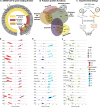A global lipid map reveals host dependency factors conserved across SARS-CoV-2 variants
- PMID: 35715395
- PMCID: PMC9203258
- DOI: 10.1038/s41467-022-31097-7
A global lipid map reveals host dependency factors conserved across SARS-CoV-2 variants
Abstract
A comprehensive understanding of host dependency factors for SARS-CoV-2 remains elusive. Here, we map alterations in host lipids following SARS-CoV-2 infection using nontargeted lipidomics. We find that SARS-CoV-2 rewires host lipid metabolism, significantly altering hundreds of lipid species to effectively establish infection. We correlate these changes with viral protein activity by transfecting human cells with each viral protein and performing lipidomics. We find that lipid droplet plasticity is a key feature of infection and that viral propagation can be blocked by small-molecule glycerolipid biosynthesis inhibitors. We find that this inhibition was effective against the main variants of concern (alpha, beta, gamma, and delta), indicating that glycerolipid biosynthesis is a conserved host dependency factor that supports this evolving virus.
© 2022. The Author(s).
Conflict of interest statement
The authors declare no competing interests.
Figures






Update of
-
A global lipid map reveals host dependency factors conserved across SARS-CoV-2 variants.bioRxiv [Preprint]. 2022 Feb 15:2022.02.14.480430. doi: 10.1101/2022.02.14.480430. bioRxiv. 2022. Update in: Nat Commun. 2022 Jun 17;13(1):3487. doi: 10.1038/s41467-022-31097-7. PMID: 35194611 Free PMC article. Updated. Preprint.
References
Publication types
MeSH terms
Substances
Supplementary concepts
Grants and funding
LinkOut - more resources
Full Text Sources
Medical
Miscellaneous

